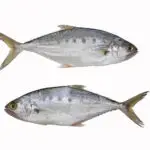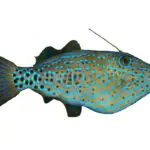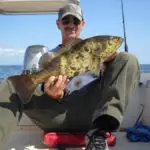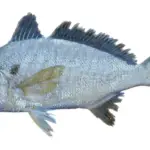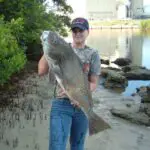If you love to catch big predatory game fish like tarpon, sharks, drum, cobia and much more… then you need to know how to properly hook a mullet to increase your hook set ratio.
In this article, ill go over 5 unique ways to hook mullet for bait, and explain the pros and cons of each method.
Table of Contents
- Through The Top Lip
- Behind The Anal Fin
- Through The Shoulders (back)
- Through Both Lips
- Bonus (Cut Bait)
- Tips For Using Mullet As Bait
- Frequently Asked Questions
- Conclusion
- Related Posts
Through The Top Lip
If I am fishing with live finger mullet, hooking them through the top lip is my go-to method. I find this to be the least harmful to the fish (which keeps it alive longer), and it has an excellent hook-up ratio.
The reason the hook-up ratio is very good is that the hook is positioned at the end of the fish, with the point facing upward.
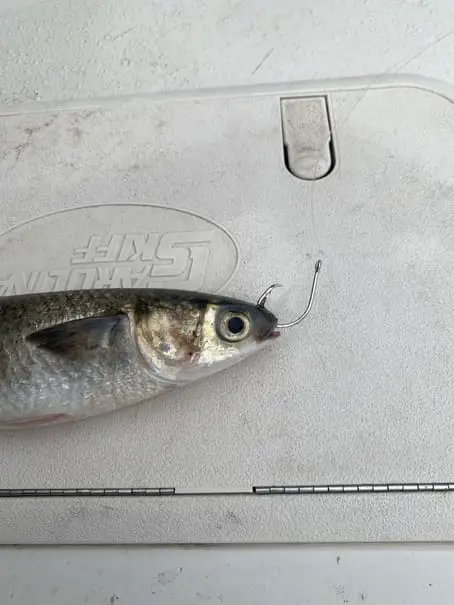
Most predatory gamefish like snook, bluefish and jack crevalle are going to approach and attack the mullet from behind, from underneath or a combination of both.
The next reason this method has an excellent hook-up ratio is that it is not hard for the hook to set, through the soft cartilage of a mullet mouth.
Unlike other methods, which require the hook to pull through tone skin or even bone, mouth hooking mullet is a great method to use, especially if your hooks keep pulling out.
The only downside to this method is that sometimes it can be difficult to cast, especially in high winds or rough seas.
You have to be delicate with your casting method, and use a slow action rod to reduce the ‘whip‘ which can mean you sling your mullet off into no-mans land!
Trust me, we’ve all done it.
Behind The Anal Fin
Hooking a mullet behind the anal fin is a great method if I want my mullet to give off a struggling swimming action.
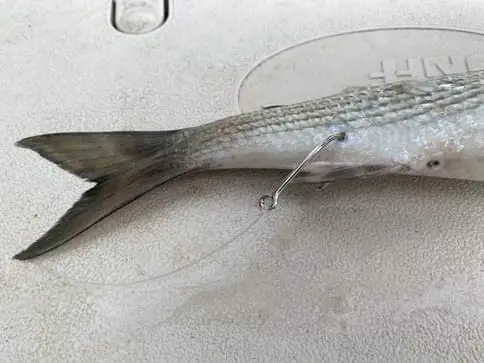
If I am fishing for reef or bottom species like mangrove snapper or goliath grouper, ill often hook my mullet behind the anal fin so they swim just above the structure.
Sometimes I have to add weight, to find that perfect balanced ratio.
This method also works well if I am trying to freeline mullet back into docks or hard to cast to areas.
By hooking them behind the anal fin, mullet will naturally swim upward and away and you can often guide them into the structure or under docks…hopefully where that giant snook is waiting.
See Also: Using Mullet For Shark Bait? Follow These Tips!
Through The Shoulders (back)
Hooking a mullet through the shoulders (upper back, just above their pectoral fins) is another common method, especially if you are fishing from a dock, pier, or jetty.
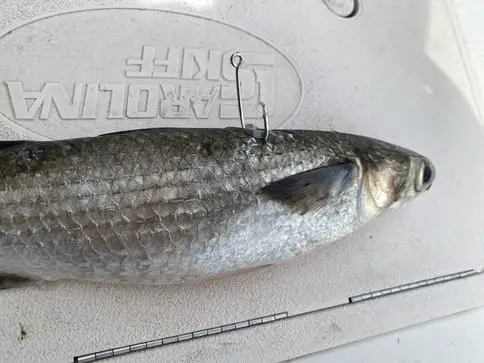
I prefer this method when I am fishing straight down from up above my target area. Hooking a mullet through the shoulders (back) and dropping it straight down will reduce the amount of drag on your bait.
When hooking through the tail, or lips each time you reel in your bait it’s creating a lot of drag through the water, which stresses your bait and will slowly cause it to die and lose its natural action.
For example, when I am fishing in Sebastian Inlet from the North Jetty (which is about 20 feet above the water), I’ll hook my mullet through the shoulders and drop them straight down on the edge of the pilings.
If fish like snook and goliath grouper are in the area, it won’t take them long to find the bait and my hook point is sticking straight out the top waiting for the hit.
This method is also very durable, meaning you can usually cast pretty far without the fear of ripping out the hook.
Through Both Lips
Normally you don’t want to hook through both lips of a mullet, because this will effectively close the mouth of a mullet making it more difficult for them to breathe water over their gills.
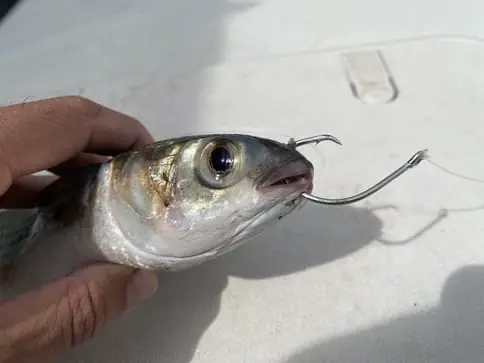
However, if my mullet is recently dead, but still fresh I will use this method because it gives me the most control over my bait.
By hooking through both lips of a mullet, you create a very strong anchor point for your hook which allows you to cast your bait far and use your rod-tip to create the life-like action of a recently dead (or almost dead mullet).
There are other times when the fishing is just on fire (like during the mullet run) and I’m in a hurry…ill just hook through both lips and get it out there.
This is especially true when Tarpon are busting bait pods off the beach, or an infamous ‘jack-attack’ when jack crevalle come crashing in eating everything in sight.
Dang, that’s fun!
Bonus (Cut Bait)
I prefer to use live mullet 80% of the time I am fishing, and each of the above methods works great and hasn’t failed me yet.
But sometimes using fresh-cut mullet as bait, and fishing it on the bottom or drifting back into a chum slick can be extremely effective.
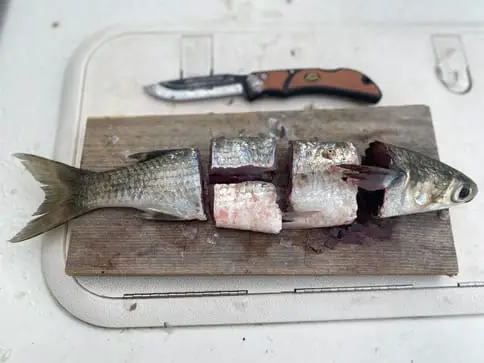
You can cut up mullet into to easy to use sections, which make excellent cut bait.
The head, midsection, and tail are the 3 main components of cut bait fishing, and on larger mullet, you can cut that midsection into two different pieces, the belly, and the back.
Big bottom feeders such as sharks, redfish, black drum, and flounder love fresh cut mullet.
And if you prefer to anchor and chum for big yellowtail snapper, mahi-mahi, grouper, or mackerel then cut mullet work very well.
Toss out chunks of mullet without a hook to get the fish comfortable and actively feeding…once you see them taking the chunks of mullet aggressively, it’s time to hook a chunk and hang on!
Tips For Using Mullet As Bait
- I strongly recommend using circle hooks when fishing with mullet, whether they are live, frozen or as fresh cut bait. They are safer on the fish, and will improve your hook up ratios.
- Always check the point of your hooks for scales. Mullet have very hard scales, and sometimes these can get stuck on the tip of your hook and if not removed, it will cost you fish!
- Always use the least amount of weight you need, to get your bait into the strike zone. Mullet will swim differently with too much lead…use just enough by slowly adding more until you get your bait where the fish are located.
- Live is better than fresh, and fresh is better than frozen, but pickers cant be choosers. In my experience, mullet will out-fish most artificial baits even if they are not live.
- To keep you mullet alive and fresh, make sure they dont overheat. Throw in a handful of ice-cubes into your bucket or live well every couple of hours. Keep them in the shade and change the water frequently.
- If you are anchored and fishing in a strong current, always hook your mullet head first. If you hook them in the tail or back, they will spin backwards against the current and quickly drown.
Frequently Asked Questions
What Size Hook For Mullet?
A good rule of thumb is to choose a hook that is as wide as the head of your mullet. For small 4-6 inch mullet this is usually 1/0 to 2/0 hook size. For larger 8-10 inch mullet, choose a 4/0-8/0 hook size.
How Do You Hook Frozen Mullet?
Frozen mullet can be hooked and rigged whole (especially for offshore fishing or trolling) or cut up and used as chunk bait.
How Do You Hook A Dead Mullet?
If the mullet is dead but still fresh, I prefer to hook them through both lips. This way I can easily cast them and give them life-like action with movement from my rod.
Your other option is to cut the mullet up into cut-bait, where you can use the head, midsection, and tail as chunks. This method works very well for surf fishing or reef fishing.
How Do You Keep Cut Mullet On A Hook?
Cut mullet usually fall off the hook because they are hooked incorrectly, or become soft and mushy. Always hook your cut mullet into the thickest part of the meat, and into the skin. Store it on ice to keep it fresh and firm.
You can also hook directly under a bone, however, this may reduce your chances of a proper hookset.
Conclusion
I always encourage anglers to experiment with different methods, to find what works best for their equipment and particular style of fishing.
There are many different ways to hook a mullet for bait, but the top 5 I outlined in this article have worked the best for me.
Be safe and have fun!
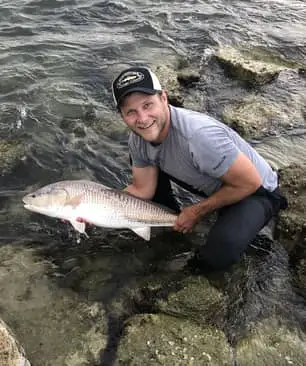
Growing up in Florida, I’ve been surrounded by saltwater my entire life…and I love sharing my passion with others.
To learn more about why I started Saltwater Mecca, visit the ABOUT page.
Thank you for reading this article. Browse around & have some fun!

